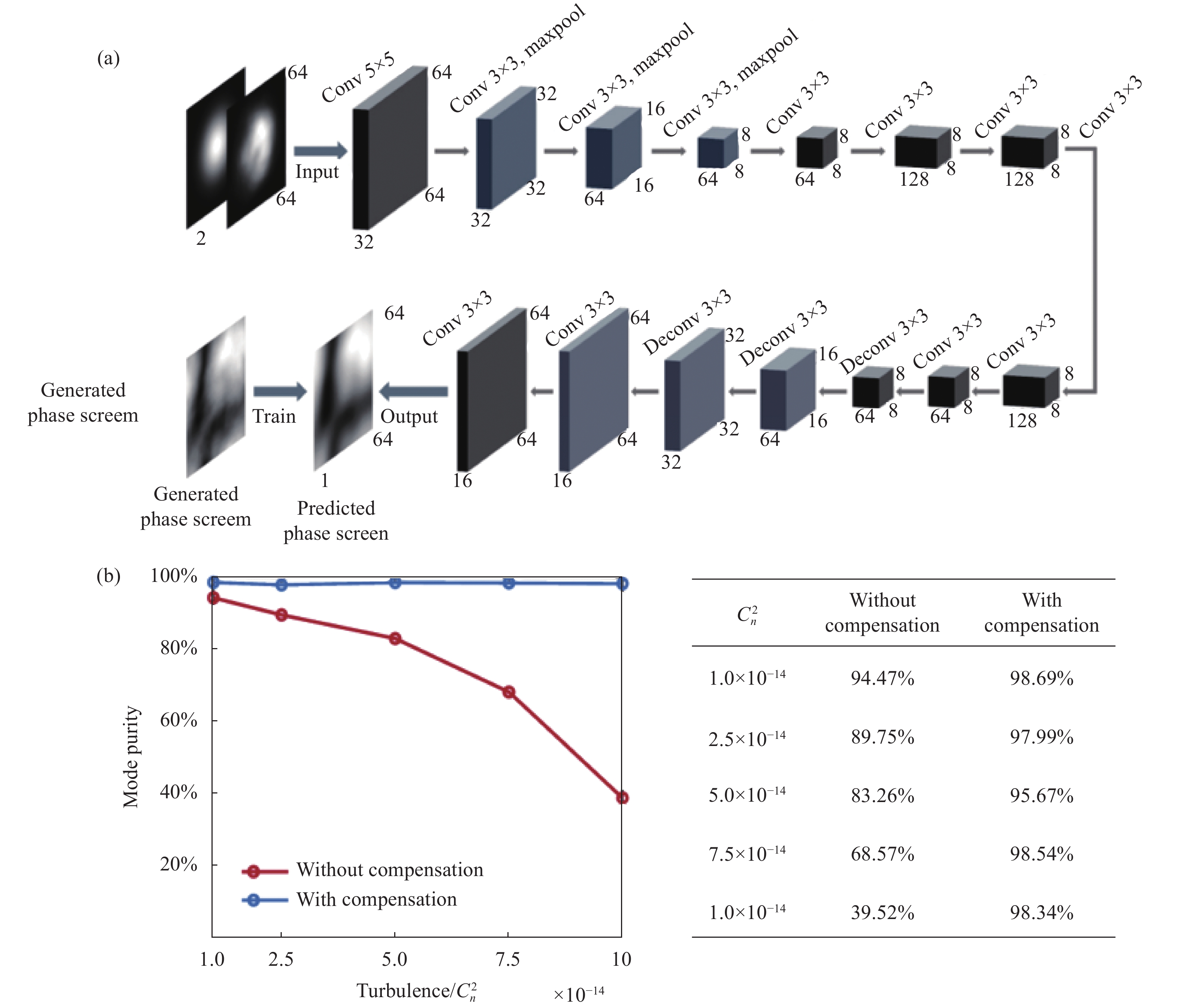-
光学涡旋,也称涡旋光束,是一种携带轨道角动量(Orbital Angular Momentum, OAM)的结构光束,其波前呈独特的螺旋型,复振幅表达式包含螺旋相位项exp(
${i}l\varphi$ ),其中l为拓扑荷数或OAM态,可取任意整数,$\varphi $ 为角向坐标[1-2]。常见的涡旋光束包括拉盖尔高斯(Laguerre Gauss,LG)光束[1]、贝塞尔高斯(Bessel Gaussian,BG)光束[3]、艾利光束[4]等。涡旋光束因其独特的光学性质,在超大容量光通信[5–11]、光信息存储[12]、光镊[13–15]、旋转探测[16-20]等领域得到广泛应用。例如,在光通信领域,不同的OAM模式相互正交构成一无穷维希尔伯特空间,使得涡旋光束可作为信息载体以模分复用的方式拓展光通信系统的复用维度以提升信道容量[6-7],由于涡旋光束OAM态的取值范围为任意整数,理论上信道容量可增至无穷[1-2]。涡旋光束在大气湍流或光纤等不均匀介质中传输时,其螺旋波前会产生畸变,使得光束的OAM谱展宽[21–23],为其实际应用带来严重影响。例如,在基于OAM的光通信系统中,光束OAM谱的展宽会引入的模间串扰,提升了系统的误比特率,降低了通信质量[24]。为了消除大气湍流造成的影响,维持系统通信的可靠性与稳定性,必须引入自适应光学技术来校正涡旋光束的波前畸变。现有面向高斯光束的自适应光学技术多采用波前传感的方式探测畸变波前[25–29],而涡旋光束由于存在相位奇点[30-31]而无法直接利用波前传感技术来探测波前信息,使得针对高斯光束的自适应光学技术并不适用于涡旋光束。为了解决这一问题,国内外学者针对涡旋光束的模式特点,开展了一系列面向涡旋光束的自适应畸变校正技术研究,提出了多种技术方案。例如,引入探针光束与涡旋光束一同传输,通过测量探针光束波前畸变得到校正相位,以校正涡旋光束[32–37];采用GS算法[36–40]、SPGD算法[41–45]等无波前探测方式校正畸变涡旋光束。这些方法虽可以得到很好的涡旋光束畸变校正效果,但分别存在系统较为复杂、系统响应时间不够短、无法匹配大气湍流的动态变化等局限,与实际工程化应用还有一定距离。为了进一步提升涡旋光束畸变校正的精度与速度,同时使自适应光学系统具有一定的学习和记忆能力,研究人员提出了基于深度学习的新型无波前传感畸变校正方案,在取得良好的涡旋光束畸变效果的同时,有效地降低了系统的复杂程度并压缩了系统响应时间。文中主要综述了现阶段较为成熟的涡旋光束畸变校正技术,详细介绍了基于深度学习的涡旋光束畸变校正研究进展。
-
大气湍流的时空非均匀性会对传输其中的涡旋光束产生影响,出现波前畸变。要弄清大气湍流对涡旋光束具体的影响,首先应了解大气湍流自身规律,其中最有代表性的是前苏联数学家A. N. Kolmogorov提出的大气湍流统计模型[46]。经过不断完善的Kolmogorov大气湍流统计模型可以直接将湍流的温度波动与折射率波动联系起来,是当前湍流理论的重要基础。1966年,J. I. Davis提出可以用大气折射率结构常数Cn2来划分大气湍流的强度[47]。同年,D. L. Fried引入大气相干长度r0表征大气湍流强度[48],它可以用来表示湍流的空间密度和强度。为具体分析大气湍流对光束传输的影响,可采用相位光栅模拟大气湍流,即大气湍流屏。常见的大气湍流相位屏建立方法包括功率谱反演法[49-50]和泽尼克多项式展开法[51]。
基于此,研究大气湍流对涡旋光束影响的工作得以展开。2013年,Y. Ren等研究了大气湍流对基于OAM复用的自由空间光链路的影响,他们发现,对于多模复用的OAM通信链路,大气湍流会引起不同OAM信道功率起伏及模间串扰,随着湍流强度的增加,模间串扰会更为严重,使得系统接收端接收到无关OAM模式的比重上升,而期望模式的比重降低,如图1(a)所示[21]。LG光束和BG光束是最常见的涡旋光束,相比于LG光束,BG光束在携带OAM的同时具有传输不变性(无衍射性),在光通信领域同样表现出应用潜力[52–54]。2016年,笔者课题组比较了大气湍流对BG光束和LG光束的影响[23],如图1(b)所示。随着湍流的增强,螺旋相位分布产生变形,湍流越强,变形越严重。在强湍流下,难以直接通过相位分布确定OAM态;并且在强湍流(Cn2 = 1×10−13 m−2/3)条件下,LG光束与BG光束均产生严重的模间串扰。在中等(Cn2 = 1×10−14 m−2/3)以及弱湍流(Cn2 = 1×10−15 m−2/3)条件下,BG光束相较LG光束的OAM谱更为发散,说明前者受到湍流的影响更大。除了标量涡旋光束,2020年,笔者课题组报道了矢量涡旋光束在大气湍流下的传输分析,证实径向偏振矢量光束比标量涡旋光束具有更好的大气湍流抗性[55-56]。
-
为解决常规自适应光学系统无法探测涡旋光束波前的问题,2014年,Y. Ren等将探针光束与涡旋光束同轴传输,且两者呈偏振正交[32]。合束的光束传输经过大气湍流后,高斯光束与涡旋光束产生了相同的畸变。而后基于夏克哈特曼波前传感器探测畸变的高斯光束相位,算出补偿相位来补偿涡旋光束。此外,考虑到大气湍流的互易性,自适应光学系统可以对自由空间光通信链路中的失真涡旋光束进行预补偿和后向补偿[33]。2016年,S. Chen等应用高斯探针光束与波前传感器校正贝塞尔光束[35]。同年,同一课题组证实该方法对多模混合涡旋光束同样有效[34],如图2(a)所示。
除了基于波前传感器的波前探测外,通过算法,例如 Gerchberg-Saxton(GS)算法[36–40]、随机并行梯度下降(Stochastic Parallel Gradient Descent,SPGD)算法[41,43–45]、模拟退火算法[57]等,可以直接从测量的强度分布中恢复畸变波前。2012年,Y. Ren等基于GS算法校正畸变的OAM模式,结果显示该技术可将OAM模式纯度提升到50%,并且将模式串扰降低了20 dB[38]。笔者课题组于2016年将GS算法与高斯探针光束结合,对LG光束[37]与BG光束[36]进行了校正。2017年,笔者课题组报道了基于GS算法的无高斯探针光束的校正方案[40],如图2(b)所示。该方案在简化光路的同时保证了良好的校正效果。除了GS相位恢复算法,2015年,G. Xie等报道了基于SPGD算法补偿畸变涡旋光束的技术方案,如图2(c)所示[43]。利用CCD相机采集光束在无湍流与有湍流条件下的光场强度分布,基于SPGD算法计算性能指标的变化,在梯度下降的方向上搜索参数,并操控波前校正器对涡旋光束校正。此外,X. Yin等提出基于混合输入-输出算法(Hybrid Input-Output Algorithm,HIOA)的自适应光学系统方案,以补偿畸变的OAM光束,如图2(d)所示[58]。与GS算法相比,HIOA提升了补偿性能和收敛速度。
-
上述常规的涡旋光束畸变校正技术存在着一定的不足,基于夏克-哈特曼波前传感器的校正方法成本较高且增加复杂的同轴系统;基于面阵探测器与GS或SPGD等算法相结合的方法存在系统响应时间长、校正精度不够的问题。机器学习是一种让机器自动从数据中学习规则的技术,其中包含一个通过神经元组网来学习复杂、抽象逻辑的方向,称为神经网络。研究人员发现深层神经网络,即包含多层神经元的网络,在多个领域取得了重大突破,部分任务上甚至超越了人类水平。深层神经网络也被命名为深度学习。随着深度学习算法[59]在语义分割[60-61]、医学图像处理[62–66]、数字全息[67–69]、计算成像[70–78]、超分辨[79–81]、图像识别[82–85]等领域取得成功,研究人员开始研究将深度学习作为一种相位提取算法。S. W. Paine等将深度学习引入波前传感[86];Y. Nishizaki等基于深度学习提出了三种不同的波前传感方案[86],T. Andersen等利用深度学习实现天文望远镜中导星图像的波前传感[87]。2018年,Y. Jin等将基于深度学习的波前传感技术引入自适应光学系统,可以有效地补偿生物组织所带来的畸变[88]。除了生物组织等畸变来源,大气湍流作为一种复杂的像差同样可以使用深度学习进行提取。2019年,H. Ma等利用深度学习从畸变的强度分布中提取大气湍流信息[89],同年,J. Gao等将深度学习应用于缓解大气湍流对图像的影响[90]。为进一步研究深度学习对大气湍流的提取能力,Q. Tian等实现了深度学习在不同湍流强度下直接从强度图像中提取湍流像差,并将其成功应用在自适应光学系统中[91]。
受此启发,深度学习算法被引入涡旋光束畸变校正领域。神经网络根据面阵探测器采集的畸变光场强度分布,学习并计算出对应的畸变相位信息。与常规校正方案相比,基于深度学习与面阵探测器的涡旋光束畸变校正方案成本较低且校正速度快、精度高。根据神经网络所输出的畸变信息,可以将基于深度学习的涡旋光束畸变校正技术分为两大类:一是神经网络反演泽尼克多项式系数[92–94];二是神经网络反演大气湍流屏[92,95–97]。
-
Zernike多项式是一组正交完备基矢,任意畸变相位屏都可以用多阶正交的Zernike多项式展开。因此,符合大气湍流统计规律的各阶Zernike多项式系数足以表达出不同强度的大气湍流。根据R. J. Noll的定义,失真的相位分布可表示为[51]:
式中:aj为第j项多项式系数;Zj为各项Zernike多项式系数。
基于泽尼克多项式表示大气湍流的方法使得神经网络输入为畸变涡旋光束强度分布,输出为泽尼克多项式系数。神经网络提取图像特征并拟合泽尼克多项式系数。Y. Zhang等于2019年提出基于卷积神经网络(Convolutional neural network,CNN)的涡旋光束自适应校正方案,大气湍流由前15阶泽尼克多项式表征[93]。CNN的输入为CMOS相机采集的畸变涡旋光束强度分布,输出为1×12的泽尼克多项式系数(前三阶泽尼克模式可被忽略或通过其他简便方式计算出来)。CNN由五层卷积层和三层全连接层组成,如图3(a)所示,每个卷积层的滤波器被随机初始化,并被训练如何从输入中提取特定的特征。损失函数选取均方误差函数。所搭建的自适应校正系统根据CNN预测的泽尼克多项式系数计算出补偿湍流屏,并加载到液晶空间光调制器上,实现对畸变涡旋光束的校正,如图3(b)所示。单次校正时间仅为~17 ms。
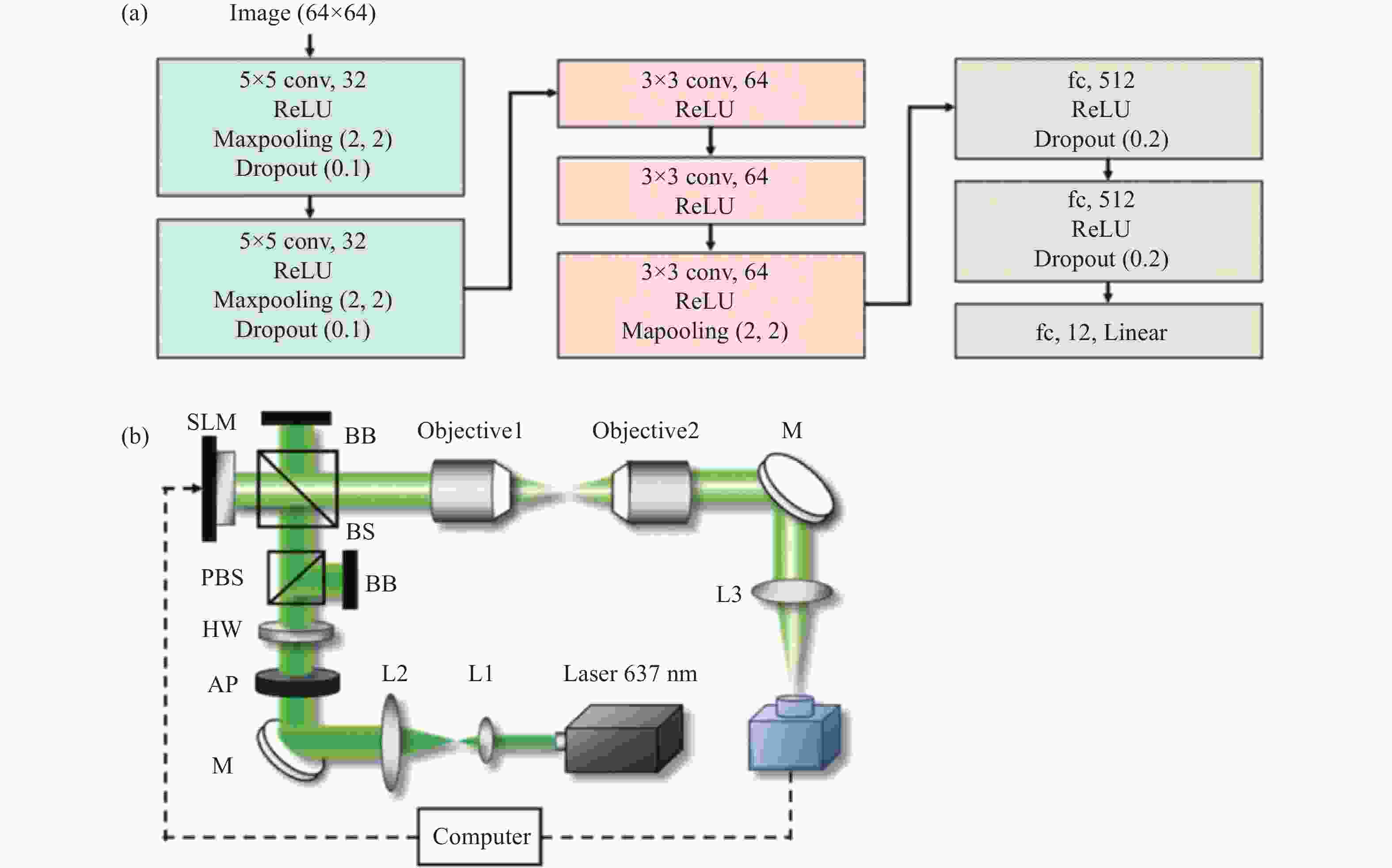
Figure 3. Compensating distorted vortex beams through CNN. (a) CNN network based on Alexnet; (b) Adaptive optics system for distorted vortex beam[93]
笔者课题组于2020年报道了基于深度学习的矢量涡旋光束畸变校正技术,其证明了基于深度学习的校正方案不单适用于标量涡旋光束[94]。该方案设计了一种湍流像差校正CNN(Turbulence Aberration Correction Convolutional Neural Network,TACCNN)模型,该模型可以学习畸变矢量涡旋光的强度分布与前20阶泽尼克模式产生的湍流相位的映射关系。TACCNN包含八个卷积层和一个全局平均池化层,卷积层分别包含32、64、128、256个大小为5×5的卷积滤波器,如图4(a)所示。经过学习大量的实验样本后,TACCNN模型快速、准确地补偿了矢量涡旋光束的湍流像差。实验结果首次表明,在D/r0=5.28的湍流强度下,畸变矢量涡旋光束的模式纯度从19%提高到70%。此外,在不同强度的大气湍流中,空间模态和光强分布都能得到很好的补偿,结果如图4(b)和(c)所示。校正结果证明基于深度学习的校正方案对标量涡旋光束与矢量涡旋光束均有效。

Figure 4. Compensating distorted vectorial vortex beams through deep learning. (a) Special TACCNN network based on Alexnet. The input is a series of images with 224×224×3 pixel, and the output is 1×20 Zernike coefficients vector; (b) The intensities of mode purity without and with turbulence, as well as after compensation; (c) Detected mode purity before and after compensation in various turbulence atmospheres (D/r0 within the scope of a value in 0-6.29). The blue bar and the pink bar represent mode purities before compensation and incremental mode purities after compensation, respectively[94]
-
大气湍流屏还可基于功率谱反演法模拟生成。与泽尼克多项式模拟大气湍流相比,功率谱反演法能够生成包含更多高频成分的大气湍流相位屏[23,49-50]。
2019年,J. Liu等设计了一种深度CNN模型,它可以自动学习输入的光束强度分布与湍流相位之间的映射关系[96]。为了同时补偿多个畸变涡旋光束,其引入了高斯探针光束(Gaussian Probe Beam,GPB)作为信息提取对象。CNN结构如图5(a)所示, 其中输入为GPB经过湍流前与经过湍流后的强度分布,输出为预测的大气湍流屏,包含12个卷积层与三个解卷积层:第一个卷积层使用大小为5×5的滤波器,其余卷积层以及解卷积层均使用3×3的滤波器。在不同湍流下强度条件下,经过补偿后涡旋光束模式纯度均大于90%;尤其在强湍流条件下(Cn2 = 1×10−13 m−2/3),模式纯度从39.52% 提升至98.34%,如图5(b)所示。2020年,同一课题组优化了校正方案,在OAM通信中,使用高斯探针光束而不加载信号,会浪费复用资源以及增加系统复杂程度,因此他们提出使用涡旋光束强度分布作为湍流特征捕获对象[95]。上述方式使得对湍流预测更加准确,且降低了系统复杂程度。

Figure 5. Deep learning based atmospheric turbulence compensation. (a)CNN model for atmospheric turbulence compensation; (b) The mode purity of vortex beam (l=3) before and after compensation, under different strength of atmospheric turbulence[96]
2021年,X. Wang等将上述自适应校正技术成功应用于量子密钥分发(QKD)系统[97]。结果表明,该方法可以有效地提高编码OAM态的模式纯度,延长所涉及的自由空间信道中QKD协议的安全距离,且不局限于任何特定的QKD协议。
-
文中回顾了近年来涡旋光束自适应畸变校正的国内外研究进展,重点介绍了基于深度学习的涡旋光束畸变校正技术。涡旋光束的自适应畸变校正是包括光通信等应用场景在内的重要技术基础之一,基于深度学习的涡旋光束畸变校正技术解决了常规校正方式时间长、精度低的不足,但也存在泛化能力弱、所需训练样本繁多等问题,因此研发在保证校正时间短、校正精度高、设备成本低的同时,能够对多种涡旋光束有效且无需大量数据样本的涡旋光束畸变校正系统是涡旋光束畸变校正技术的发展方向之一。
Advances in the compensation of distorted vortex beams through deep learning (invited)
doi: 10.3788/IRLA20220221
- Received Date: 2022-03-25
- Rev Recd Date: 2022-06-10
- Publish Date: 2022-08-05
-
Key words:
- vortex beam /
- adaptive optics /
- deep learning /
- atmospheric turbulence /
- wavefront correction
Abstract: Vortex beam is a kind of novel structured beam with helical wavefront and carries orbital angular momentum (OAM). Such structured field can find applications in many domains as large-capacity data transmission, remote detection, etc. The wavefront aberration occurs when the vortex beam propagates in a non-homogeneous medium as atmosphere turbulence, resulting in the OAM changing and go against practical applications. Therefore, it is necessary to compensate distorted vortex beams through adaptive optics. The recent advances on adaptive correction of distorted vortex beams was mainly reviewed. The current mature correction schemes were firstly introduced in brief, including wavefront sensing along with probe Gaussian beams, array detection along with phase retrieval algorithms, and so on. Then the deep-learning-based approaches were highlighted, as Zernike polynomial coefficients inversion, turbulence phase screen inversion, etc. The advantages and limitations of employing deep learning for distorted vortex beam compensation were also discussed. Finally, development trends of distortion compensation of vortex beams were prospected.



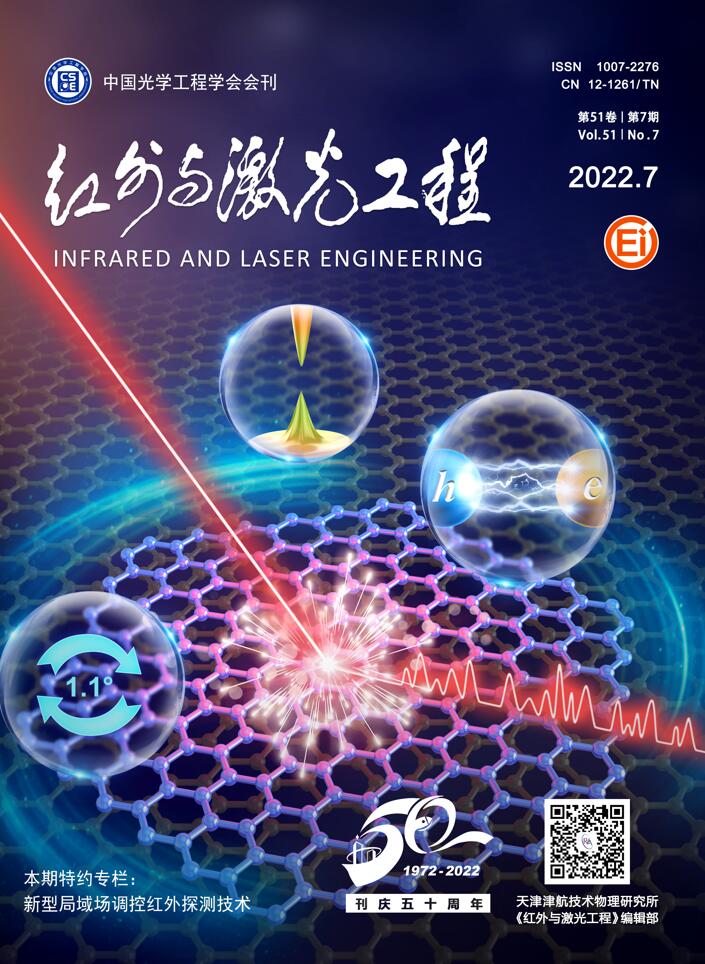







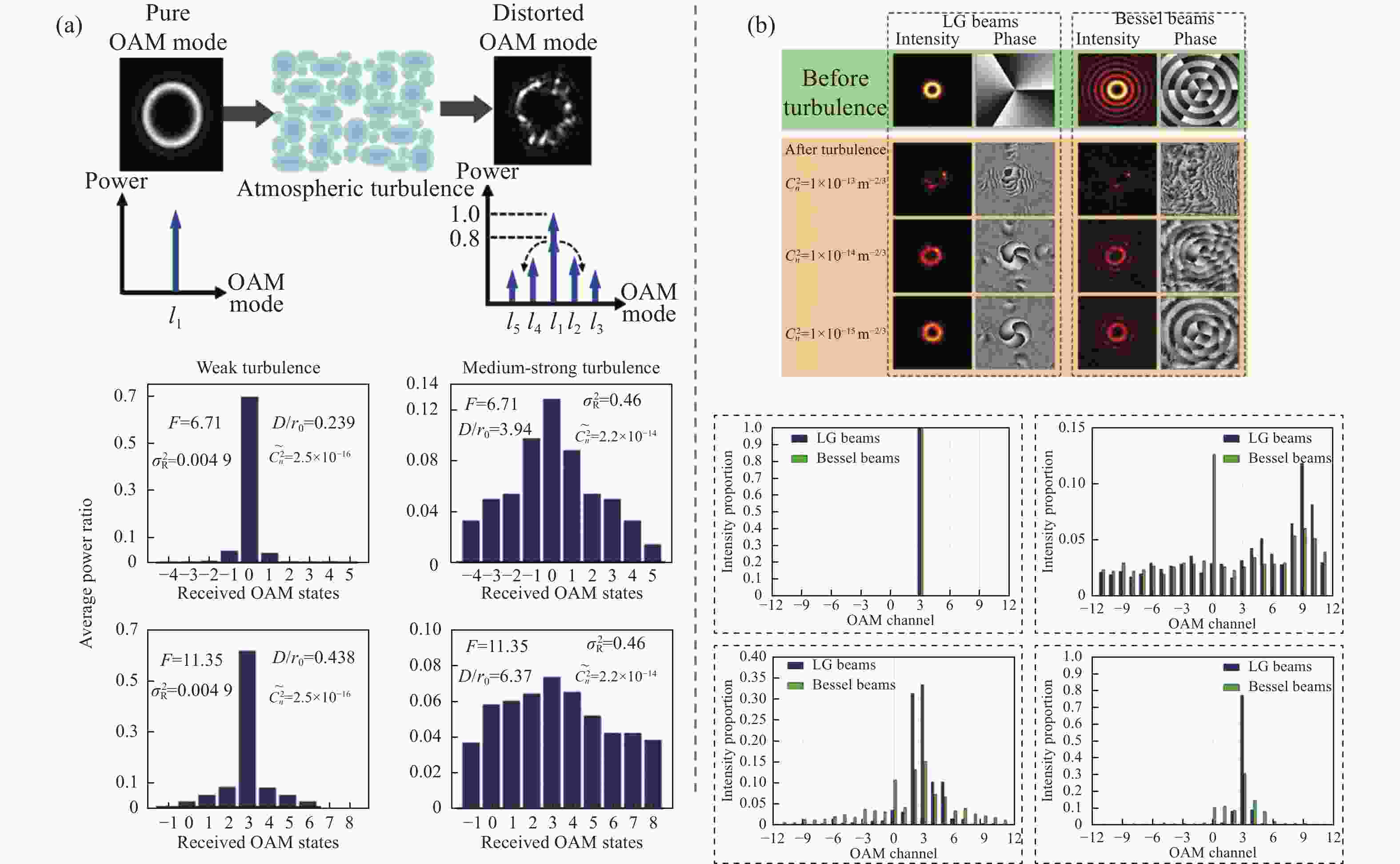
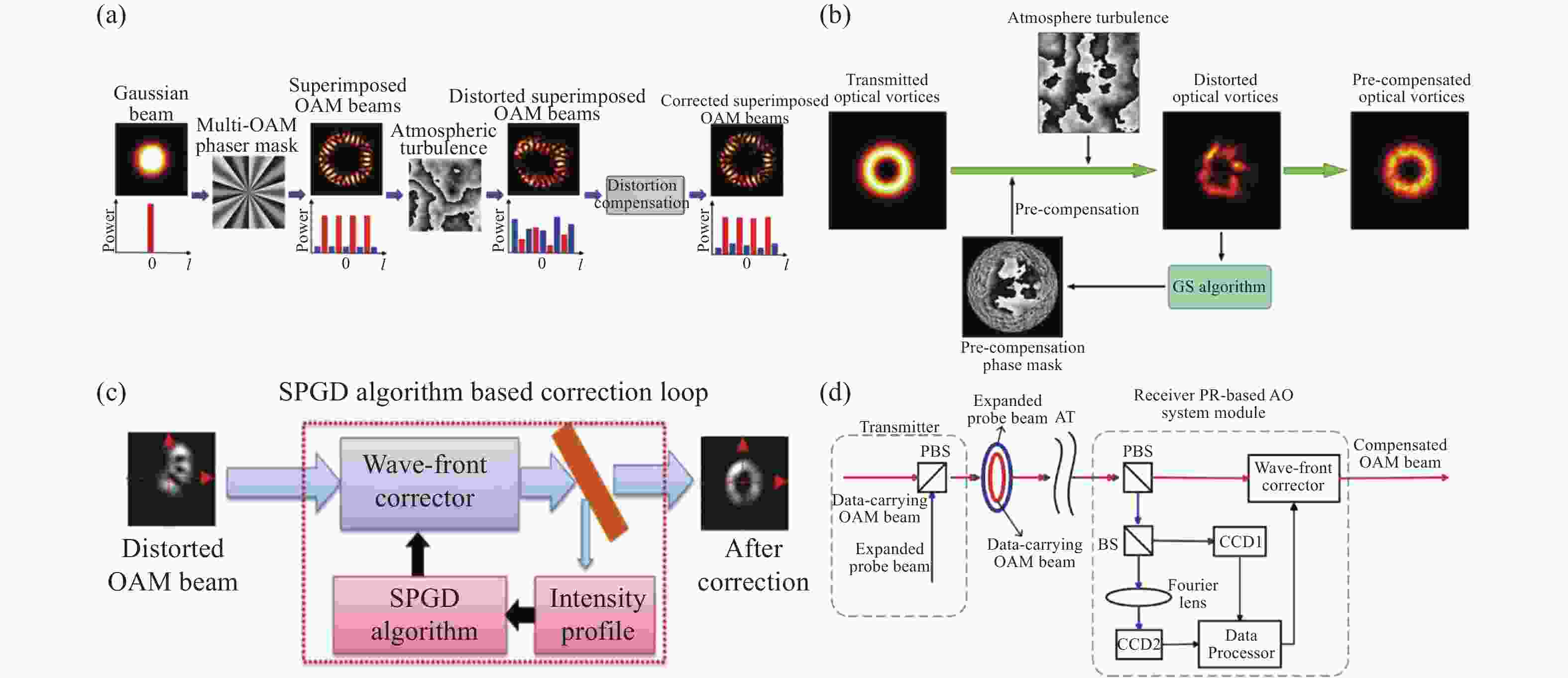

 DownLoad:
DownLoad:



